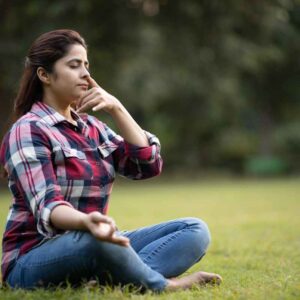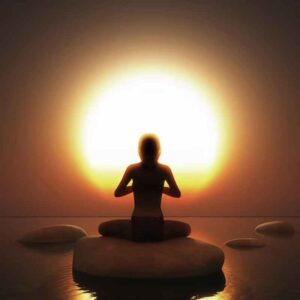Types Of Pranayama And Its Benefits in 2024

“Pranayama” is made from 2 Sanskrit words – “prana” meaning life energy and “yama” means control or expansion. Pranayama is a breathing practice which is helpful in increasing bodily energy, releasing stress, and improving physical health and mental wellness. In pranayama you generally inhale, hold the breath and exhale it through the nostrils.
It is said that the breath is connected to the mind, and by consciously regulating the breath, one can influence and channelize the body and mind.
Benefits Of Pranayama

The significance of pranayama in the practice of yoga and overall health lies in its transformative impact on both the body and mind. Here are key points that highlight its importance:
Connection of Body and Mind:- Pranayama serves as a crucial link between the physical and mental aspects of yoga. The breath is considered a bridge connecting the body’s vital energy (prana) and the mind’s consciousness. Scientific studies show that by practicing Pranayama various benefits can be unlocked which will better your health.
Improves Lung Function:- Practicing pranayama daily for about 1 hour can significantly improve lung function and its breathing capacity. This technique can help to recover from various lung diseases like asthma, pneumonia, etc.
Reduce Stress:- Pranayama focuses on breathing technique, in which we slowly exhale and inhale breath with focus, this induces a state of relaxation, counteracting the effects of stress and promoting a sense of calm.
Energy Flow and Balance:- Pranayama is believed to balance the flow of energy (prana) within the body. Techniques like Nadi Shodhana aim to clear energy channels, ensuring a harmonious distribution of life force throughout the system.
Reduces High Blood Pressure:- High blood pressure, also known as hypertension, is when your blood pressure, the force of your blood pushing against the walls of your blood vessels, is consistently too high. It increases the risk for some potentially serious health conditions like cardiac arrest and stroke. To reduce High BP you need to practice Pranayama daily as in this you can concentrate on your breathing, it can help calm your nervous system. This, in turn, may help reduce your risk of hypertension.
Preparation for Meditation:- If you are not good at meditation then try Pranayama first, this will positively help you in meditation. Pranayama calms the body and mind and helps you to focus on things easily by controlling your breath, in this way you can do meditation comfortably.
Increases Sleep Quality:- Sleep quality will be better if your mind is in relaxing mode and stress free. This stress free and relaxing mind can be done through doing Pranayama.
Types Of Pranayama
There are various types of Pranayama which can be performed if you have joined yoga teacher training in Bali:-
-
Bhastrika Pranayama –

Bhastrika Pranayama is a dynamic and energizing breathing exercise in the yogic tradition. It involves forceful inhalation and exhalation through the nose, creating a rhythmic and audible breath. This pranayama is taught in yoga teacher training in Bali.
Steps To Perform Bhastrika Pranayama:
Starting Position – Sit comfortably in a cross-legged position (Padmasana or Sukhasana) with a straight spine.
Place your hands on your knees with palms facing upward (Jnana Mudra) to enhance the meditative aspect.
Breathing Technique – Inhale forcefully and deeply through both nostrils, expanding your lungs fully.
Exhale forcefully and completely, contracting your abdominal muscles to expel the air.
Rhythmic Movements – Maintain a steady and rhythmic pace with equal duration for inhalation and exhalation.
The breath should be audible, and the movement should come from the diaphragm.
Repetition – Start with a moderate pace and gradually increase the speed, maintaining control and awareness.
Beginners can start with 1-2 minutes and gradually extend the duration with practice.
-
Surya Bhedi Pranayama –

Surya Bhedana Pranayama, also known as “Right Nostril Breathing” is a yogic breathing technique that involves breathing through the right nostril while keeping the left nostril closed. According to yogic tradition, the right nostril is associated with the “Pingala” energy channel, which is related to the sun (Surya) and is considered to be heating and energizing. This pranayama is taught in yoga ttc in bali.
Steps To Perform Surya Bhedana Pranayama:
Starting Position – Sit comfortably in a cross-legged position (Sukhasana or Padmasana) with a straight spine.
Place your hands on your knees with palms facing upward (Jnana Mudra) for a meditative posture.
Nasal Positioning – Use your right thumb to close your left nostril gently. Ensure that the rest of your fingers are extended and relaxed.
Inhalation – Inhale slowly and deeply through your right nostril. Focus on the breath as it fills your lungs. Keep the left nostril closed throughout the inhalation.
Retention – After a full inhalation, close your right nostril with your right ring finger, keeping both nostrils closed (Antar Kumbhaka or internal breath retention).
Exhalation – Release the left nostril and exhale slowly and completely through the left nostril. Keep the right nostril closed throughout the exhalation.
Repeat – This completes one round. Continue the cycle by inhaling through the right nostril, retaining the breath, and exhaling through the left nostril.
-
Nadi Shodhana Pranayama –

Nadi Shodhana Pranayama, also known as “Alternate Nostril Breathing” or “Anulom Vilom,” is a yogic breathing technique that involves alternating the breath between the left and right nostrils. The term “Nadi Shodhana” translates to “channel purification,” referring to the purification of the subtle energy channels (nadis) in the body. This practice is known for its balancing and calming effects on the nervous system. You can learn this Pranayama in Bali vinyasa yoga school.
Steps To Perform Nadi Shodhana Pranayama:
Preparation – Sit comfortably in a cross-legged position (Sukhasana or Padmasana) with a straight spine.
Place your left hand on your left knee in Jnana Mudra (palms facing upward).
Use your right thumb to close your right nostril and your right ring finger to close your left nostril.
Initial Breath – Start by taking a few natural breaths to settle into the practice.
Closing the Right Nostril – Close your right nostril with your right thumb.
Inhale through the Left Nostril- Inhale slowly and deeply through your left nostril, filling your lungs.
Closing Both Nostrils – Close both nostrils using your right thumb and ring finger, holding your breath for a brief moment.
Opening the Right Nostril – Release your right nostril (keeping the left closed) and exhale slowly and completely through the right nostril.
Inhale through the Right Nostril – Inhale deeply through your right nostril.
Closing Both Nostrils – Close both nostrils again, holding your breath briefly.
Opening the Left Nostril – Release your left nostril (keeping the right closed) and exhale through the left nostril.
Repeat the Cycle – This completes one cycle. Continue the sequence by inhaling through the left nostril, holding, exhaling through the right nostril, and so on.
Closing – Conclude the practice by finishing with an exhale through the left nostril.
-
Bhramari Pranayama –

Bhramari Pranayama, often referred to as “Bee Breath,” is a calming and soothing breathing technique that involves producing a sound similar to the humming of a bee. This practice is known for its ability to reduce stress, calm the mind, and promote a sense of inner peace.
Steps To Perform Bhramari Pranayama:
Preparation – Find a quiet and comfortable place to sit in a cross-legged position (Sukhasana or Padmasana) with a straight spine. Rest your hands on your knees in Jnana Mudra (palms facing upward).
Relaxation – Close your eyes gently and take a few deep breaths to relax your body and mind.
Closing the Eyes and Ears – Using your thumbs, gently close your ears by pressing the tragus (the flap-like projection in front of the ear canal).
Closing the Mouth – Close your mouth, keeping your teeth slightly apart. Your lips should remain closed but not tense.
Inhalation – Inhale deeply and slowly through both nostrils, filling your lungs with air.
Exhalation with Humming Sound – As you exhale, make a gentle, steady humming sound, similar to the buzzing of a bee. Allow the sound to be smooth and continuous throughout the exhalation. Feel the vibration of the sound in your head.
Focus on the Sound – Concentrate on the humming sound and the vibration it creates. Let the sound be a natural extension of your breath.
-
Ujjayi Pranayama –

Ujjayi Pranayama, often called “Ocean Breath,” is a breathing technique commonly used in various forms of yoga. It involves creating a soft hissing or ocean-like sound by constricting the back of the throat during both inhalation and exhalation. This technique helps deepen the breath and has a calming effect on the nervous system.
Steps To Perform Ujjayi Pranayama:
Posture – Sit comfortably in a cross-legged position (Sukhasana or Padmasana) or any comfortable seated posture with a straight spine. Relax your shoulders and place your hands on your knees in Jnana Mudra (palms facing upward).
Relaxation – Close your eyes and take a few natural breaths to relax.
Inhalation – Inhale slowly and deeply through your nose. Make sure your mouth is closed.
Constriction of the Throat – As you inhale, slightly constrict the muscles at the back of your throat, creating a soft hissing or ocean-like sound.
Full Inhalation – Inhale until your lungs are completely filled with air. Feel the expansion of your chest and ribcage.
Exhalation – Exhale slowly and completely through your nose while maintaining the constriction of the throat. Again, produce the ocean-like sound during the exhale.
These are a few pranayamas which are mentioned above and are important ones and if you are keen and enthusiastic to learn and understand about it then you can join yoga teacher training in bali where you will be taught this if you want to make a career as a yoga teacher.
Conclusion
In this blog we learned about Pranayama and its benefits. There are many people who are practicing pranayama in their daily routine but some people who want to become yoga teacher and want to skill these techniques can join Yoga teacher training program where different types of Pranayama like Bhastrika Pranayama, Surya Bhedi Pranayama, Nadi Shodhana Pranayama, Bhramari Pranayama, Ujjayi Pranayama, etc are taught.
